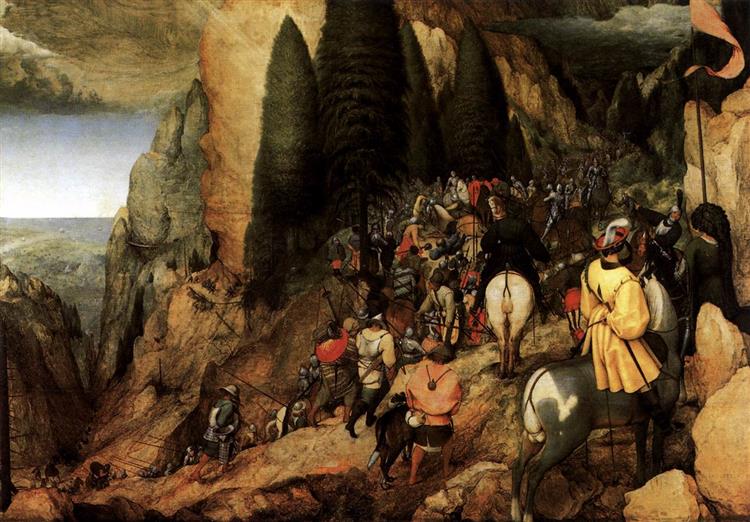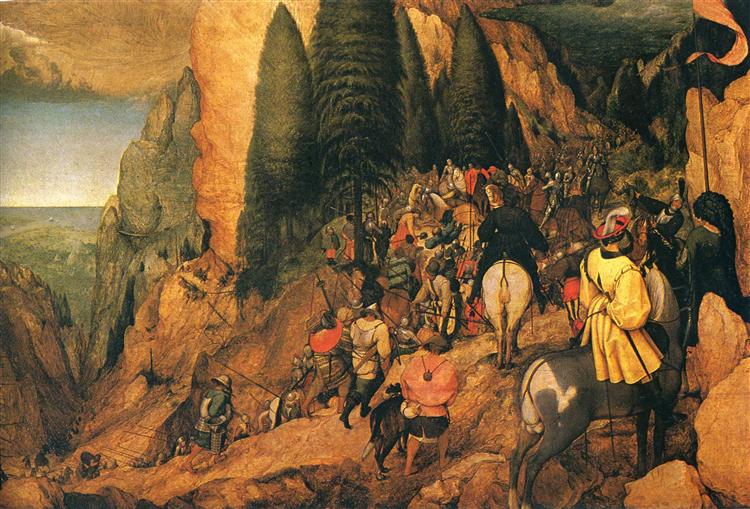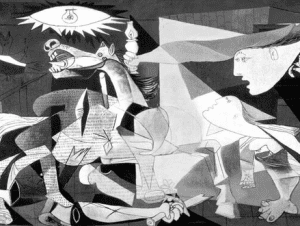Pieter Bruegel the Elder’s 1567 oil-on-panel painting, The Conversion of St. Paul, stands as a monumental work of the Northern Renaissance. While its subject is a pivotal moment in Christian scripture, the artwork transcends simple religious illustration. Through a masterful and unconventional compositional strategy, Bruegel presents a complex commentary on faith, pride, and the contemporary political turmoil of his era. The painting is a significant holding of the Kunsthistorisches Museum in Vienna, Austria.

Conversion of St. Paul by Pieter Bruegel the Elder
Historical and Biblical Context
The painting depicts the narrative from the Acts of the Apostles (9:3-7), in which Saul, a fervent persecutor of Christians, is struck by a divine light while traveling to Damascus. This miraculous event blinds him and leads to his conversion, after which he adopts the name Paul and becomes a principal apostle.
Bruegel deliberately renders this ancient event in a contemporary 16th-century setting. The soldiers are depicted in period armour, and the saint himself is shown in the blue doublet and hose common in the artist’s day. This anachronistic approach was a calculated artistic choice, intended to emphasize the enduring relevance of the biblical story for his audience, particularly during the intense religious conflicts of the Reformation and Counter-Reformation.
Compositional Analysis: A Mannerist Approach
One of the most striking aspects of The Conversion of St. Paul is its compositional structure. In a departure from traditional religious painting, Bruegel de-emphasizes the protagonist. St. Paul is a relatively small figure located in the middle distance, almost lost amidst the teeming mass of soldiers and horses winding through a steep, pine-clad mountain pass.
This technique is a characteristic device of the Mannerist style. By placing the principal subject deep within the pictorial space, behind prominent but narratively incidental foreground figures, the artist compels the spectator to actively search the canvas. This strategy creates a profound sense of depth and encourages intellectual engagement with the work, forcing the viewer to look beyond the immediate and discover the scene’s true meaning. The eye is drawn into the painting in its search for the central event, turning the act of viewing into one of discovery.
Symbolism and Contemporary Relevance
Beyond its biblical narrative, the work functions as a powerful moral allegory concerning the sin of pride and the necessity of faith. Saul’s journey represents human arrogance, which is literally brought to the ground by divine intervention, illustrating a universal theme of humility and conversion.
Furthermore, some art historians have proposed a compelling political interpretation of the scene. The depiction of a massive army crossing a mountain pass may allude to the 1567 march of the Duke of Alba, Don Fernando Álvarez de Toledo, into the Netherlands. He led a Spanish army of 10,000 men to suppress the Dutch revolts against Spanish rule. In this context, the painting could be read as a veiled commentary on the political and religious persecution facing the Netherlandish people at the time of its creation.
Painting Specifications
Artist: Pieter Bruegel the Elder (c. 1525–1569)
Title: The Conversion of St. Paul
Original Title: Omzetting van St. Paul
Date: 1567
Medium: Oil on panel
Style: Northern Renaissance
Dimensions: 108 cm x 156 cm
Location: Kunsthistorisches Museum, Vienna, Austria
Viewing the Work at the Kunsthistorisches Museum
The Conversion of St. Paul is a celebrated component of the extensive Bruegel collection at the Kunsthistorisches Museum in Vienna. To fully appreciate its scale, intricate detail, and compositional genius, it is best viewed in person. Prospective visitors are advised to consult the museum’s official website for current exhibition details and visiting hours.









Responses